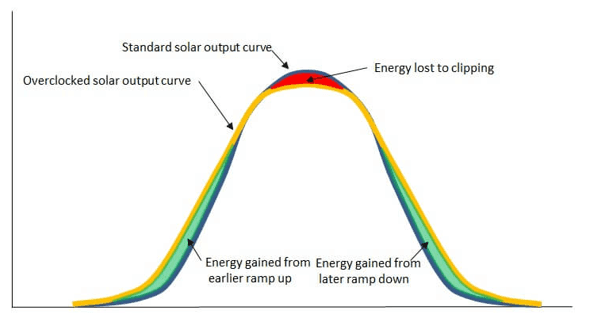The Australian public is getting very savvy when it comes to solar. Most consumers now know about oversizing a solar array and its benefits. But it is always worth going over things again.
What is Oversizing
In simple terms oversizing is when you put a larger wattage of panels than the wattage of the inverter. For example, putting 6.6kW of panels with a 5kW inverter. Generally speaking, the maximum wattage of solar panels an installer can install cannot exceed 133% of the inverter’s kW rating.

Inverter Limitations
Inverters are split into two halves “input” and “output”, For example, a 5kW inverter can give an output of 5kWh to your house and the grid. But the input is the wattage of panels you can put into the inverter.
Some inverters are limited in the amount of input wattage it will allow. For example, some 5kW inverters only allow a maximum of 5kWh input. But other inverters will allow a much larger input of wattage. The Fronius 5kW inverter will allow up to 10kWh of input and an ABB 5kW inverter will allow up to 8kWh of input. But we are still limited to 133% of the inverter’s rating by regulations.
So, the ability to oversize your solar array and the amount by which you can oversize is dependent on the brand of inverter.
It is also important to remember that regardless of the wattage input, an inverter output is restricted by its rating. Even if the regulations still allowed us to put 10kW of panels with a 5kW Fronius inverter, your output would still be only 5kWh.
Why Oversize
More Electricity in the Mornings and Early Evenings
In simple terms, the more panels you have the more energy you produce. This means you produce more electricity in the mornings and more electricity in the evenings, so, your inverter starts earlier in the morning and shuts down later in the evenings. When you consider that most families increase their energy use in the mornings and in the early evenings, the more energy you can generate the more savings you will make.
Overcast Days
Similarly, on overcast days, the extra panels help produce more energy. For example, let’s assume you have a 5kW inverter with 5kW of panels. If the cloud cover reduces production by 50% you will only have 2.5kWh to send to the grid. If you have a 5kW inverter with 6.6kW of panels. A 50% production loss will be 3.3kWh.
Improved Efficiency
No installation is 100% efficient. You can expect to lose approximately 10% of output as the electricity runs through the cabling to the inverter. Inverters do not run at 100% efficiency. The angle of your panels on the roof and the direction they are facing can affect energy production. More panels help your system get closer to its maximum potential.
Small Technology Credits (STC’s)
STC’s are often referred to as the Government Rebate. The total number of STC’s you get towards your solar installation is based on the total wattage of your panels. The government assistance is on the panels not the inverter, racking or labor costs of the installation. By oversizing, you are getting a bigger bang for your investment buck.
Talk to Symons Energy today about oversizing your system.
